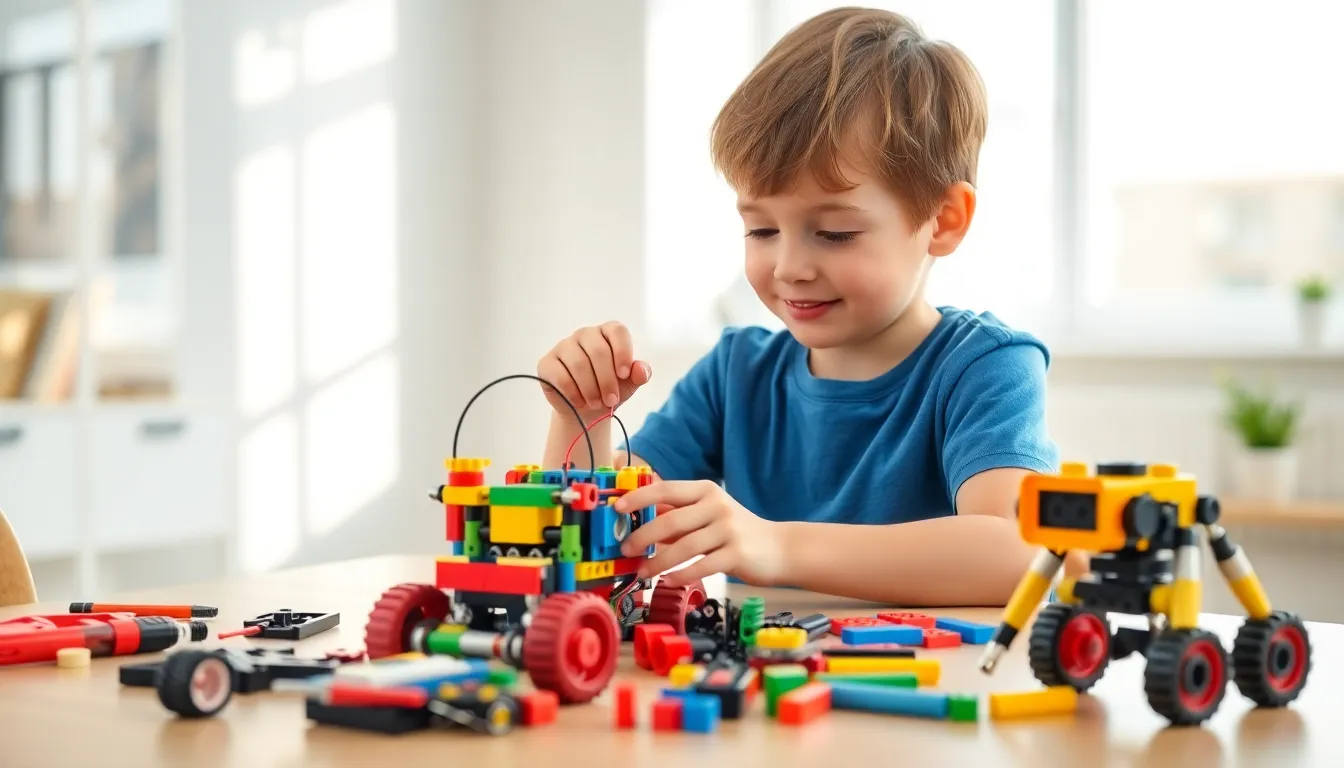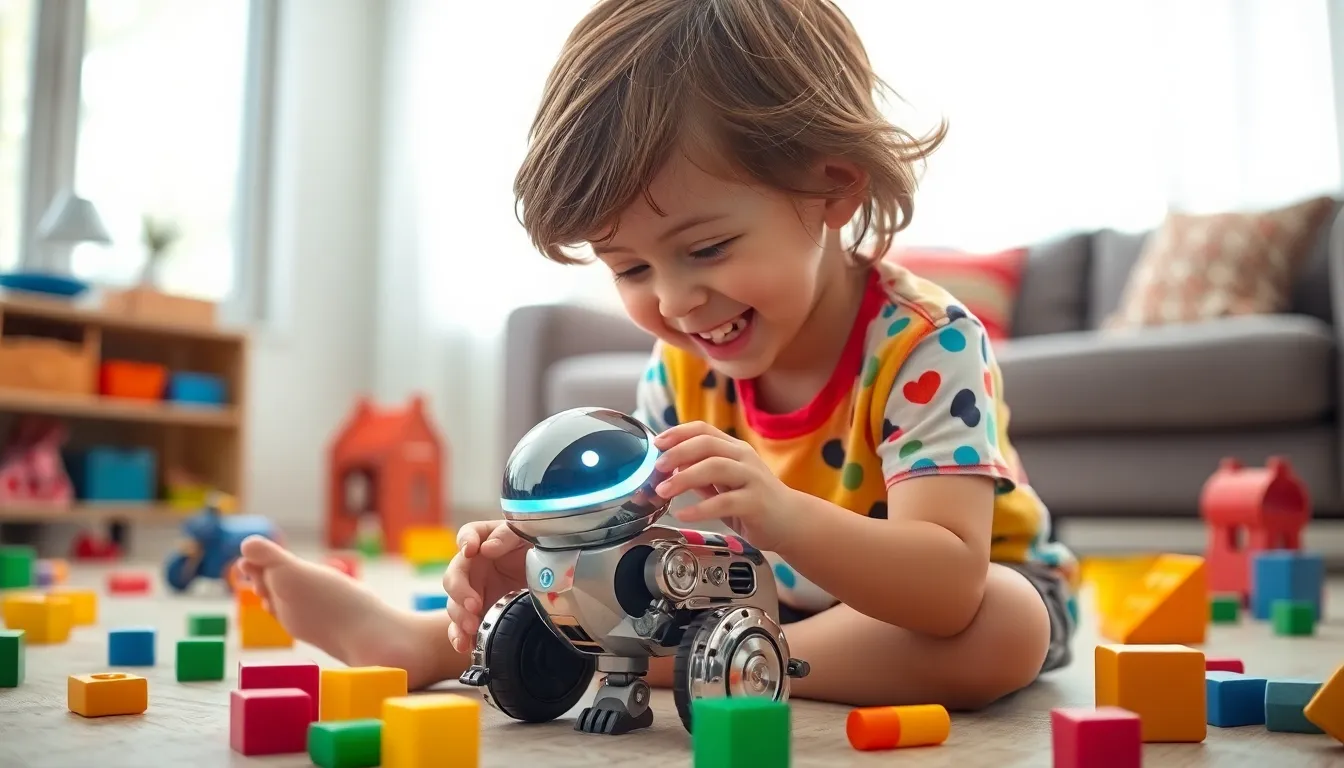In a world where toys are no longer just plastic figurines, robotic toys have taken playtime to a whole new level. These high-tech marvels don’t just sit on the shelf; they dance, talk, and even learn. Imagine a robot that can teach your child math while doing the cha-cha. Sounds like something out of a sci-fi movie, right? Well, welcome to the future!
Table of Contents
ToggleOverview Of Robotic Toys
Robotic toys represent a significant advancement in playtime technology. These devices engage children through interactivity, offering experiences beyond mere physical manipulation. Features such as voice recognition and motion sensors enable robots to respond to commands and track movements.
Educational value drives the popularity of these toys. They often teach coding, problem-solving, and basic scientific principles. Robotics kits allow children to build and customize their own robots, encouraging creativity. Interactive storytelling through robotic characters enhances engagement, turning playtime into an immersive experience.
Safety considerations are paramount in the design of robotic toys. Manufacturers adhere to strict safety standards to ensure that materials used are non-toxic and durable. Well-designed robotic toys promote learning while keeping children safe during their play.
Market trends indicate a growing demand for these innovative toys. In 2022, the global market for robotic toys exceeded 2 billion USD, with projections pointing to continual growth. Manufacturers adapt to consumer preferences by introducing advanced features like app integration and artificial intelligence, enhancing user experiences.
Robotic toys also appeal to various age groups. Not only do they cater to young children, but also to older kids and even adults who appreciate the engineering aspects. This versatility broadens their market reach and potential impact on future learning methodologies.
Overall, robotic toys blend fun with learning in ways traditional toys cannot match. Their potential to educate while providing entertainment sets them apart in the evolving landscape of children’s play. As technology advances, these toys remain at the forefront of interactive and educational entertainment.
Types Of Robotic Toys

Robotic toys come in various forms, each offering unique features and engagement levels.
Educational Robots
Educational robots teach coding and critical thinking. These interactive toys often incorporate games and challenges, making learning enjoyable. Kids can program their robots to perform specific tasks, reinforcing STEM concepts in a hands-on manner. Many educational robots have sensors and lights, providing instant feedback to users. Popular models include Botley and LEGO Mindstorms, designed for different age ranges. Their ability to simplify complex ideas encourages creativity and problem-solving skills.
Interactive Pets
Interactive pets simulate real-life companionship. These robotic animals respond to touch, sound, and movements. Features like voice recognition make the interaction more engaging. Popular choices include robotic dogs and cats that can perform tricks and express emotions. Children experience empathy and responsibility while caring for their virtual pets. Battery-operated models often have educational components, teaching kids about animal behavior and care. Advancements in AI enhance their responsiveness, mimicking natural behaviors effectively.
Build-and-Program Kits
Build-and-program kits allow children to create robots from scratch. These kits often include various components, such as motors, sensors, and programming tools. Kids explore engineering concepts while assembling their designs, fostering innovation. Brands like LEGO and Sphero offer kits suitable for beginners and advanced users. The programming aspect empowers kids to customize functionalities, enhancing their coding skills. Challenges and competitions related to these kits further motivate students to excel in robotics.
Benefits Of Robotic Toys
Robotic toys offer numerous advantages, enhancing playtime while promoting learning and development. These benefits contribute to why parents increasingly choose them for their children.
Enhancing Cognitive Skills
Robotic toys significantly foster cognitive skills in children. They often include coding lessons and logic games that challenge young minds. Problem-solving becomes easier through hands-on challenges specifically designed for engagement. Additionally, sensors and voice recognition provide interactive experiences, enhancing critical thinking. For example, toys like Botley encourage kids to plan routes and solve puzzles, directly affecting their cognitive development.
Promoting Creativity
Creativity flourishes with robotic toys, allowing children to explore their imaginative capabilities. Build-and-program kits enable kids to design their robots, forming a direct connection between creativity and technological understanding. While constructing, they learn by trial and error, becoming innovators in the process. The artistic aspects of decorating and personalizing robots further stimulate creative expression. Units like LEGO Mindstorms not only teach functionality but also invite imaginative play.
Encouraging Social Interaction
Social interaction improves with playful robotic toys. Engaging in cooperative activities fosters teamwork skills among peers. Children often play in groups, facilitating communication while developing social skills. The presence of interactive pets encourages empathetic behavior through nurturing relationships. When they share experiences with robotic toys, connection and collaboration among friends enhance, making playtime a social learning opportunity.
Considerations When Choosing Robotic Toys
Choosing the right robotic toy involves various factors that cater to different needs and preferences.
Age Appropriateness
Age appropriateness ensures that children engage with toys that match their developmental stage. Many robotic toys come with recommended age ranges, guiding parents to suitable options. For instance, simple interactive pets are ideal for preschoolers, while coding kits are tailored for older children. Younger kids enjoy engaging features without complex operations. Educational toys that teach advanced skills, like programming and robotics, cater to children aged eight and above. Opting for toys designed for specific age groups enhances the play experience while ensuring safety and educational value.
Safety Features
Safety features play a crucial role in robotic toys, emphasizing durability and non-toxic materials. Manufacturers adhere to stringent safety guidelines to protect children during play. Many toys undergo thorough testing to ensure components are safe for handling, especially for younger users. Look for certifications, such as the ASTM or CPSIA, which indicate compliance with safety standards. Toys equipped with protected battery compartments and rounded edges contribute to a secure play environment. Selecting robotic toys with these safety features provides peace of mind in addition to engaging play experiences.
Robotic toys are transforming the landscape of playtime by merging entertainment with education. Their interactive features not only captivate children’s attention but also foster essential skills like coding and problem-solving. As technology continues to evolve, these innovative toys will likely become even more integral to childhood development.
Parents can feel confident in choosing robotic toys that meet safety standards while providing enriching experiences. With a wide variety of options available, there’s something for every age group. The future of playtime is bright with robotic toys leading the way, making learning fun and engaging for children everywhere.





